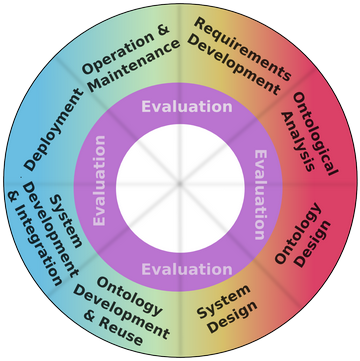From OntologySummit2013 Communique
Ontologies are human-intelligible and machine-interpretable representations of some portions and aspects of a domain. Since an ontology contains terms and their definitions, it enables the standardization of a terminology across a community or enterprise; thus, ontologies can be used as a type of glossary. Since ontologies can capture key concepts and their relationships in a machine-interpretable form, they are similar to domain models in system and software engineering. And since ontologies can be populated with or linked to instance data to create knowledge bases, and deployed as parts of information systems for query answering, ontologies resemble databases from an operational perspective.
You need a common vocabulary for a community to share knowledge. Ontologies are meant to provide that vocabulary.
Currently, there is no agreed on methodology for development of ontologies, and there is no consensus on how ontologies should be evaluated. Consequently, evaluation techniques and tools are not widely utilized in the development of ontologies. This can lead to ontologies of poor quality and is an obstacle to the successful deployment of ontologies as a technology.
This document focuses on the evaluation of five aspects of the quality of ontologies: intelligibility, fidelity, craftsmanship, fitness, and deployability.
To determine the quality of an ontology, we need to evaluate the ontology as a domain model for human consumption, the ontology as a domain model for machine consumption, and the ontology as deployed software that is part of a larger system. In this document, we focus on five high-level characteristics:[1]
1. Can humans understand the ontology correctly? (Intelligibility)
2. Does the ontology accurately represent its domain? (Fidelity)
3. Is the ontology well-built and are design decisions followed consistently? (Craftsmanship)
4. Does the representation of the domain fit the requirements for its intended use? (Fitness)
5. Does the deployed ontology meet the requirements of the information system of which it is part? (Deployability)
This document also contains the Ontology Life Cycle Model and is certainly worth a read.
 So why is this document important?
So why is this document important?
Ontologies play different roles in information systems, natural language based analytics and knowledge discovery.
Having a consistent view of Ontologies and the process of building one can immensely impact the shared knowledge in any organization. They improve communication, ability to contribute to the shared knowledge, better searching. They provide great tools for efficiently organize information and provide better context for automated agents.
Links
2 thoughts on “LinkLog: Ontology Summit 2013 Communique”
Comments are closed.